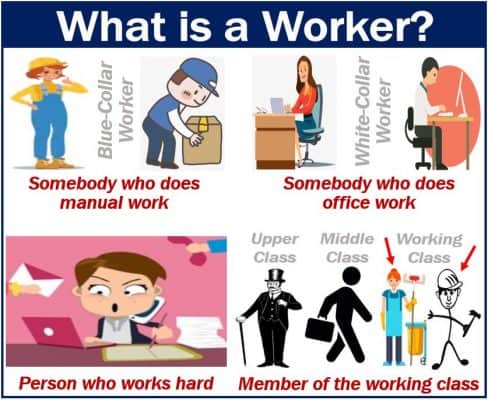A worker may be a person who works. Often, but not always, the term refers to a person with a manual or industrial job. However, we sometimes use the term with the same meaning as ’employee,’ as in: “Apple Inc. has more than 123,000 workers.”
The term may also refer to a member of the working class. Many people divide society into three classes: the working class, middle class, and upper class. Bill Gates and King Charles, for example, belong to the upper class. Salaried lawyers, librarians, high school teachers, and other professionals belong to the middle class. A gardener, window cleaner, or miner are part of the working class.
In biology, workers are sexually underdeveloped and sterile members of an ant, bee, wasp, or termite colony. Workers perform most of the colony’s labor. Some workers also carry out protective duties.
If somebody works hard, it is common to refer to that person as a worker.
Definition
The term “worker” can have several meanings.
It may simply refer to someone who does a specific type of work or performs tasks in a certain way, or more generally, it can mean an employee – typically one involved in manual or non-executive tasks.
Additionally, the term can describe someone who works hard, and in other contexts, it’s often used to denote the working class.
This article focuses on the meaning of the term when it relates to jobs.

Worker – a factor of production
Factors of production are an economy’s building blocks. In other words, they are the inputs that people use to produce goods and deliver services.
We divide the factors of production into four categories:
Labor
Labor refers to the effort that people contribute to the production of goods and services.
A worker is in this category. Engineers, architects, drivers, or anybody who works are also in this category.
Land
This factor includes land as well as anything that comes with the land. Forests, minerals, and rivers, for example, come with the land. Therefore, they belong to this category.
Capital
Capital includes buildings, machinery, and tools. It includes those elements that people use to produce things. Computers, vehicles, hammers, conveyor belts, and forklift trucks, for example, belong to this category.
Entrepreneurship
We can also refer to this factor of production as enterprise. It is what people need to combine labor, capital, and land. In other words, what we need to combine the other factors of production.
Blue-collar and white-collar worker
Blue-collar
A blue-collar worker is a working-class individual who does manual labor. In other words, they work with their hands, i.e., they do physical work.
A mechanic, window-cleaner, or somebody who works on the production line of a factory is a blue-collar worker.
White-collar
A white-collar worker does non-manual work. In other words, non-physical work. For example, an office clerk or bank teller is a white-collar worker.
We can use the term ‘white-collar’ in various situations. For example, a white-collar crime refers to a crime that people commit in the office.
An accountant who commits fraud is involved in white-collar crime. Computer hacking is also another example of white-collar crime.
Worker vs. employee
We often use the two terms interchangeably. However, there are situations in which we can only use one term.
For example, it would sound strange if we referred to a member of the board of directors as a worker. If we had to choose between ‘worker’ and ’employee,’ most people would choose ‘employee’ when referring to a company director.
Legally, in most countries, an employee has entered into or works under the terms of a contract. Specifically, a contract of employment. The contract does not necessarily have to be a written one. It may be an oral contract or even one what is implied by the nature of the relationship.
A worker has a ‘half-way house’ status between self-employed and employee. Legally, a worker is entitled to fewer statutory rights than an employee.
